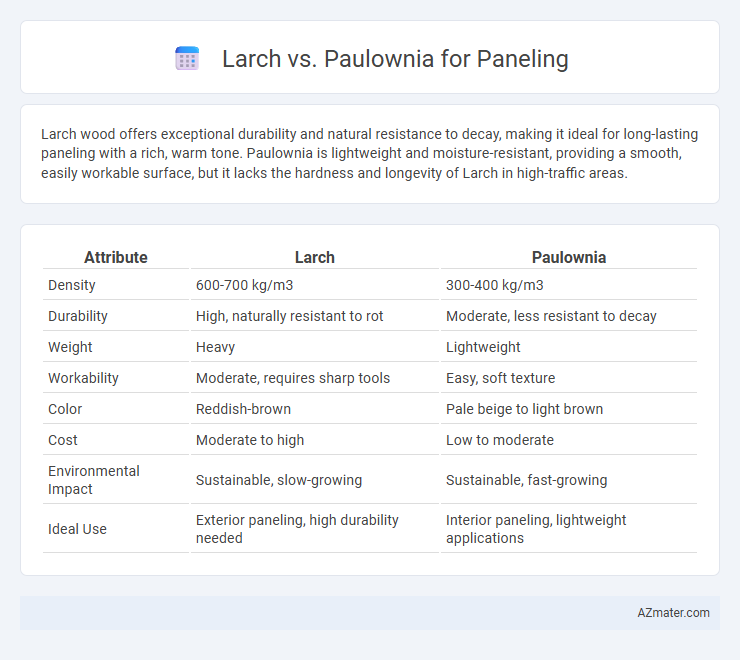Larch wood offers exceptional durability and natural resistance to decay, making it ideal for long-lasting paneling with a rich, warm tone. Paulownia is lightweight and moisture-resistant, providing a smooth, easily workable surface, but it lacks the hardness and longevity of Larch in high-traffic areas.
Table of Comparison
| Attribute | Larch | Paulownia |
|---|---|---|
| Density | 600-700 kg/m3 | 300-400 kg/m3 |
| Durability | High, naturally resistant to rot | Moderate, less resistant to decay |
| Weight | Heavy | Lightweight |
| Workability | Moderate, requires sharp tools | Easy, soft texture |
| Color | Reddish-brown | Pale beige to light brown |
| Cost | Moderate to high | Low to moderate |
| Environmental Impact | Sustainable, slow-growing | Sustainable, fast-growing |
| Ideal Use | Exterior paneling, high durability needed | Interior paneling, lightweight applications |
Introduction to Larch and Paulownia Wood
Larch wood is known for its high durability, dense grain, and natural resistance to decay, making it an excellent choice for paneling in both interior and exterior applications. Paulownia wood is lightweight, fast-growing, and features a fine, even texture with minimal shrinking or warping, ideal for decorative paneling requiring a smooth finish. Both woods offer unique benefits, with Larch providing strength and longevity while Paulownia emphasizes ease of handling and aesthetic appeal.
Botanical Overview and Origins
Larch (Larix spp.) is a deciduous conifer native to cooler regions of the Northern Hemisphere, particularly Europe, Siberia, and North America, known for its dense grain and natural durability in paneling applications. Paulownia (Paulownia tomentosa), originating from China, is a fast-growing deciduous hardwood recognized for its lightweight, large grain pattern, and resistance to warping, making it a popular choice for decorative paneling. Both species offer distinct botanical characteristics and historical uses, with Larch valued for strength and rot resistance, and Paulownia prized for its rapid growth and dimensional stability.
Physical Characteristics Comparison
Larch wood is renowned for its dense grain and high resin content, making it highly durable and resistant to rot, which is ideal for paneling in humid environments. Paulownia, on the other hand, is significantly lighter with a more uniform, fine grain and low density, offering superior insulation but less natural durability compared to larch. When selecting wood for paneling, larch provides robust strength and weather resistance, while paulownia offers ease of handling and aesthetic appeal with its smooth texture and lighter color.
Durability and Longevity
Larch wood offers superior durability and natural resistance to decay, making it ideal for paneling in environments subject to moisture and wear. Paulownia, while lightweight and fast-growing, lacks the density and hardness of Larch, resulting in lower longevity and susceptibility to dents and scratches. Choosing Larch for paneling ensures a longer-lasting surface that maintains structural integrity over time, particularly in high-traffic or exterior applications.
Weight and Workability
Larch wood is significantly heavier, averaging around 650 kg/m3, providing robust durability but requiring more effort during installation. Paulownia is remarkably lightweight, approximately 270-320 kg/m3, which enhances ease of handling and reduces labor time for paneling projects. Workability favors Paulownia due to its softer texture and excellent machinability, while Larch's dense grain demands sharper tools and more skillful craftsmanship.
Aesthetic Appeal and Grain Patterns
Larch wood offers a rich, warm tone with striking knots and pronounced resin canals that create a rustic, textured aesthetic ideal for traditional paneling. Paulownia features a lighter, more uniform color with subtle, straight grain patterns contributing to a modern, clean appearance in interior applications. The choice between Larch and Paulownia hinges on desired visual impact: Larch emphasizes natural ruggedness and depth, while Paulownia provides smoothness and a minimalist elegance.
Insulation and Acoustic Properties
Larch wood offers superior insulation and sound absorption qualities due to its dense grain structure, making it effective for thermal regulation and noise reduction in paneling applications. Paulownia, being lighter and more porous, provides moderate insulation but excels in acoustic dampening by diffusing sound waves, which is beneficial in reducing echoes. Choosing between Larch and Paulownia for paneling depends on prioritizing higher thermal insulation with Larch or enhanced acoustic performance with Paulownia.
Environmental Impact and Sustainability
Larch wood, known for its natural durability and resistance to decay, is often harvested from sustainably managed European forests, offering a renewable resource with a moderate carbon footprint. Paulownia, a fast-growing hardwood native to Asia, sequesters carbon rapidly due to its high growth rate, making it an eco-friendly option with efficient land use and minimal need for pesticides. Choosing between larch and paulownia for paneling depends on sourcing practices, with paulownia typically providing a more sustainable profile through quicker regeneration and enhanced carbon capture.
Cost and Market Availability
Larch wood generally has a higher market availability and is more cost-effective for paneling compared to Paulownia, which remains relatively niche and pricier due to limited supply. Larch offers durability and moisture resistance at an affordable price, making it a preferred choice in construction and interior applications. Conversely, Paulownia, prized for its lightweight and aesthetic grain, commands a premium cost and faces limited distribution, impacting its accessibility for widespread paneling use.
Which Wood Is Better for Paneling?
Larch wood offers durability and natural resistance to moisture, making it an excellent choice for indoor and outdoor paneling where long-lasting performance is critical. Paulownia is lightweight and easy to work with, but it lacks the hardness and moisture resistance of Larch, which may reduce its suitability for areas prone to humidity. For paneling requiring robust strength and weather resistance, Larch is generally the better wood option.

Infographic: Larch vs Paulownia for Paneling
 azmater.com
azmater.com